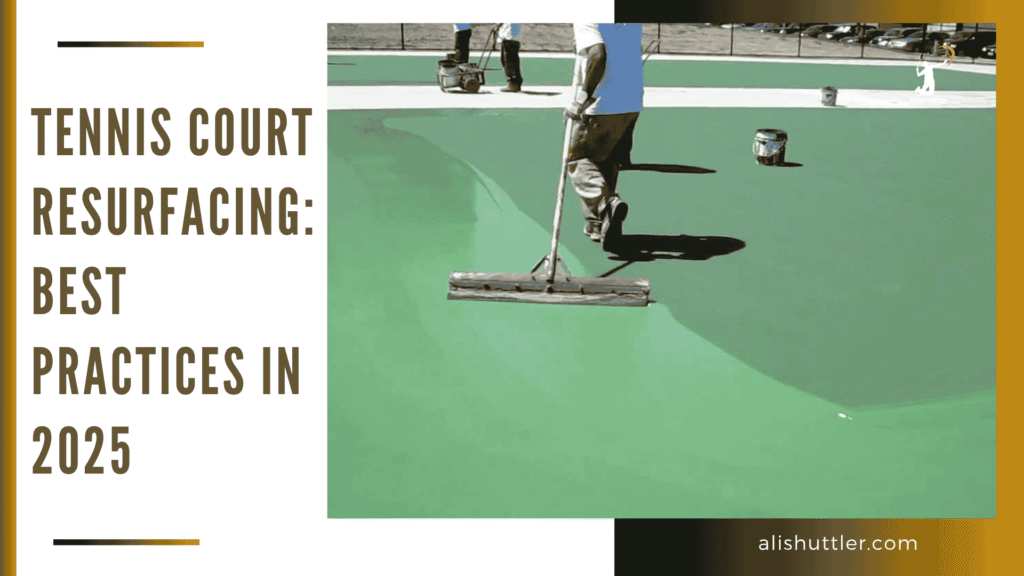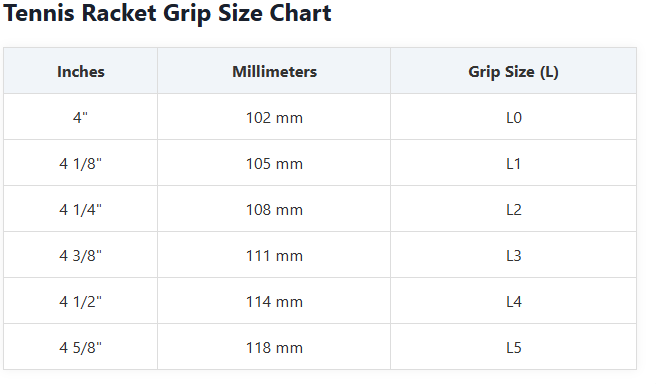Tennis court resurfacing refers to repairing the surface of a tennis court to bring back traction, smoothness, and vibrancy. Over time, courts can develop cracks, faded lines and rough patches due to weather or heavy use.
A new surface keeps players healthy and the game flowing. Asphalt, concrete or clay courts all require resurfacing on a fixed schedule. The following sections describe the how, what and when of resurfacing.

Resurfacing Rationale
Tennis court resurfacing is an essential part of maintaining tennis courts to be safe, playable, and beautiful. According to worldwide benchmarks, courts require resurfacing every 3–8 years, depending on use and maintenance. The right tennis court resurfacing contractor can reduce risks, increase play, and revitalize appearance.
Player Safety
Cracks and holes tend to pop up after seasons of play or tough weather. Patching these in a timely manner prevents players from stumbling or sliding. A court with bad drainage can collect water, creating slick spots that increase the risk for falls.
Frequent inspections identify damage or loose surfaces before they become serious. Toss in an extra padded layer and you can soften those hard landings, making the game safer and more comfortable for all.
Court Performance
A well-maintained court provides even bounce and excellent traction, both of which are essential for competitive play. Surface wear, such as faded spots or rough patches, alters ball velocity and bounce, impacting the game.
Resurfacing on schedule—every 4–7 years for hard acrylic courts, or 15+ years for premium artificial turf—assists maintain play smooth and even. Selecting the appropriate surfacing material is crucial; for example, certain acrylic coatings may accelerate or decelerate play, allowing facilities to cater to varying player preferences.
Even light, consistent use alters the court, so periodic inspections assist keep play optimal.
Aesthetic Appeal
Vibrant, fresh colors make courts appear newly constructed and pull players onto them. After a while, stains, scuffs and faded lines cause a court to look tired, even if it still plays great.
Scrubbing and painting keep things from looking scuffed. A few locations even toss in custom lines or designs, making each court pop and appear more professional.
Resurfacing nets, benches and fences around the court assist in setting a welcoming tone for regulars and visitors alike.
Asset Value
A maintained court can go 5–10 years before a new surface is necessary. Having good records of repairs and upgrades helps demonstrate the court’s value to prospective buyers or renters.
Routine maintenance pays off by identifying issues early and preventing costly repairs. Providing a new, secure court can generate increased event or lesson bookings, making the asset more valuable in any market.
Resurfacing Best Practices
Tennis court resurfacing is a multi-step process that requires planning and the proper materials. Instead, the best results come from a methodical approach, using resurfacing best practices and regular maintenance checks to prolong court life and play quality.
A systematic surface preparation approach includes:
- Clear the court of loose debris, leaves, and contaminants
- Pressure wash with something less than 70 p.s.i., or they’ll be torn apart.
- Fill holes and cracks wider than 3 mm (1/8”) with acrylic-based sealant.
- Resist and cover puddles that submerge a 2 cm coin an hour after rain.
- For smooth trowel finish concrete, shot blast to CSP 3 or 4
- Dry thoroughly, as moisture can ruin new coatings
- Let concrete cure—28 days, asphalt—30 days before resurfacing
1. Surface Preparation
Regular purging is the secret. Courts should be washed down a minimum of once a month to prevent dirt and debris from depositing. This not only assists with the appearance of the court but primes it for repair work.
Prior to resurfacing, employ a pressure washer (set no higher than 70 p.s.i.) to eliminate stains and ingrained grime. Notice those puddles that linger an hour after rain. Identify these holes with chalk and patch them in the prep phase.
For smooth-finished concrete courts, shot blasting is a necessity. Target a CSP 3 or CSP 4, so new coatings adhere.
2. Crack Repair
Examine the entire court for cracks and measure their width. Small cracks can become worse quickly, so address them promptly. Fill any crack wider than 3 mm (1/8″) with a quality acrylic-based sealant.
Today’s crack repair systems hold up better, providing a more level foundation for what follows. Stay ahead of the curve with routine inspections to identify emerging fissures and seal them before they expand. This is faster and more economical in the end.
3. Material Application
Employ the proper instruments. A rubber blade of 50 to 60 durometer, rounded edge, works best for resurfacing. Distribute in an even layer for a smooth finish.
Adhere to the maker’s directions for layering and drying. Check the weather before you begin. Most effective when it’s 10º C (50º F) and climbing, early in the day, on a cool court.
4. Curing Process
Let each layer dry as directed. Test the weather—stay away from days with too much moisture. Don’t step on the court with it.
Hold off on play until curing is done.
5. Line Striping
Use top-grade paint for tennis court resurfacing projects. Mark lines only after curing for smooth playing surfaces.
Surface Materials
Selecting the appropriate surface material is an essential component of tennis court resurfacing projects. The choice of tennis court surfaces dictates how the game plays, how much maintenance costs the court requires, and how expensive the entire resurfacing project will be. The table below contrasts some of the primary choices, highlighting their play characteristics, upkeep, and other considerations.
| Surface Type | Key Characteristics | Play Style Suitability | Durability | Maintenance Needs | Cost Range |
|---|---|---|---|---|---|
| Acrylic | Customizable, many colors, UV-resistant | All-round, fast pace | 4-8 years | Low | Moderate |
| Asphalt | Hard, cost-effective, resilient | Fast play, hard-hitting | 4-8 years | Medium (sealing needed) | Low to moderate |
| Clay | Cushioned, natural, slow pace | Baseline, topspin, longer rallies | 2-3 years | High (frequent grooming) | Moderate to high |
| Synthetic Turf | All-weather, low-maintenance, multi-use | Versatile, softer underfoot | 12-20 years | Very low | High (initial) |
Acrylic
Acrylic courts are notable for their durability and low maintenance. They’re great for tennis and other racquet sports such as pickleball and badminton. The color coatings are formulated to withstand intense sun and UV rays, so the court maintains its appearance for years.
Acrylic is available in nine standard colors and custom shades, allowing clubs and schools to align with their branding. Flexible acrylic binders maintain that rubber granule feel for decades. Repairs are easy as well—cracks can be patched with acrylic elastomeric sealants.
With proper use, play remains sleek and fluid. Most acrylic courts require resurfacing every 4–8 years, less than clay but more than synthetic turf. The resurfacing process typically requires 3–6 days, depending on the court’s condition.
Asphalt
Asphalt is a popular hard court choice due to its lower cost compared to other materials. It’s tough and can endure tons of play, which makes it a natural pick for clubs and public parks.
Asphalt erodes from the elements and usage, so it requires routine sealing to prevent cracking. If unsealed, water and sun can pulverize the surface. Maintenance includes sweeping debris, court washing and sealing cracks as soon as they appear.
With routine maintenance, asphalt courts can last 4–8 years before re-surfacing. Asphalt is great for high-speed games and is best for venues requiring a cost-effective solution.
Clay
Clay courts provide a distinctive sensation, decelerating the ball and facilitating extended exchanges. A lot of players prefer the organic spring-like feel, which is gentler on knees and ankles.
Clay courts require more maintenance than hard or synthetic alternatives. Daily grooming, watering and topping up the surface are all necessary to maintain clay courts. These courts require resurfacing every 2–3 years, as the wear of the top layer is quicker than with acrylic or asphalt.
Seasonal work, such as patching and leveling, comes with owning a clay court.
Synthetic Turf
Synthetic turf is all-the-rage for its low maintenance and all-weather handling. It maintains a firm playing surface year round and is excellent for high rainfall areas.

It requires less maintenance than clay or hard courts. The initial investment is greater, but the long-term economy is in minimal resurfacing—artificial turf has a 12–20-year lifespan.
It works well for clubs who want courts to double as multi-sports.
Cost-Effective Methods
To discover affordable methods to resurface a tennis court is to examine every possibility, from materials to project management. Each court has different requirements, so it’s crucial to align solutions with what suits your area, your budget, and your future plans.
Compare the main methods and material costs in the table below:
| Method/Material | Typical Cost (per m²) | Lifespan (years) | Benefits | Drawbacks |
|---|---|---|---|---|
| Acrylic (DIY or Pro) | $15–$35 | 4–8 | Versatile, easy upkeep | Not as durable as other |
| Artificial Turf | $25–$50 | 8–15 | Soft, good for multi-use courts | Needs regular brushing |
| Modular Tiles | $35–$60 | 10–20 | Quick install, low maintenance | Higher upfront cost |
| Basic Asphalt Overlay | $20–$40 | 6–12 | Cost-effective, strong base | Needs proper drainage |
Cost and availability differ by location. Quality materials up front makes your courts last longer, stretching your budget further down the line. Routine inspections and basic maintenance can identify problems in their infancy, minimizing expensive repairs.
DIY Approach
Yours is a DIY project to reduce resurfacing expenses if you prepare accordingly and apply the appropriate machinery. Start with a checklist: pressure washer, crack filler, patching compound, squeegee, acrylic resurfacer, paint, line tape, and safety gear.
These fundamentals get you ready, repair and seal the court for hard action. Follow step-by-step instructions. Wash the court, repair small cracks, level small depressions and dry between each coat. Little repairs first—such as caulking cracks—prevent water from getting in and causing more damage down the road.
Enlisting neighbors or local players to volunteer their labor can reduce costs and cultivate a communal sense of ownership. Volunteer efforts go a long way, particularly for communal or public courts.
Material Selection
Discover cost-effective, durable solutions for your hard, clay or turf court! Acrylic coatings represent a strong choice for the majority of traditional courts, as they are hassle-free to upkeep. Obtain quotes from local vendors. Inquiry about bulk discounts and delivery fees.
Occasionally regional brands are more cost-effective than big names. Consider long-term maintenance. Less expensive coatings might require additional touch-ups, driving up costs over time. Material or service warranties can be really cost effective in the end.
Greener alternatives—water-based acrylics, for example—may prove economical if they wear as well as traditional ones.
Phased Projects
- Inspect the court and list all needed repairs.
- Address the most imminent damage, such as deep cracks or drainage, to maintain the court’s safety and playability.
- Schedule upgrades or resurfacing for phase #2…doing the work during down times so users are not disrupted.
- Budget and court usage frequency should time each step.
Community Funding
Local clubs, schools or governments might provide grants for public court enhancements. Certain organizations cooperate with sponsors to subsidize expenses. Crowdfunding and fundraisers can generate supplemental income—particularly when combined with volunteership.
Even modest contributions can accumulate—to help keep costs low for all.
Environmental Factors
Tennis court resurfacing is influenced by a combination of local weather, material options, and environmental factors, impacting the aesthetics and playability of many tennis courts and their overall maintenance costs.
Climate Influence
Temperature swings test the strength of court surfaces. Hot summers can soften asphalt, making it prone to cracks. In colder months, freezing and thawing cycles may split or warp the surface layer, especially if water seeps in and expands.
These stresses mean the right maintenance schedule will look different depending on the region. For example, winter prep in northern areas may involve sealing cracks and clearing drains to stop water from freezing inside the court. In humid places, it’s important to check how long it takes for coatings or paint to dry. High humidity slows down curing, which can trap moisture in the surface and cause bubbles or peeling later.
Eco-Friendly Options
Sustainability becomes a growing focus in tennis court resurfacing. Recycled or locally sourced materials in the construction of the courts reduce waste and minimize the project’s carbon footprint. Full–depth reclamation (FDR) is just such an example, in that it repurposes the current asphalt and stone layers, reducing the demand for new materials.
With asphalt production tied to 1.3% of global CO₂ emissions, FDR or no, this stuff matters for the climate. Courts can opt for PFAS-free surfaces, a family of chemicals that persist in soil and water. Water management is key too—permeable surfaces and clever drainage prevent rainwater pooling, so the court remains playable and runoff doesn’t erode neighboring land.
Communities can bring awareness by supporting ball and other tennis gear recycling programs – an important effort considering there are more than 125 million tennis balls thrown away annually in the U.S. Alone.
UV Degradation
Sunlight decomposes court surfaces. UV rays fade the color and weaken the top layers, which can cause cracks or rough spots over time. UV-resistant coatings not only increase the life of the surface, but they reduce maintenance frequency.
Routine sun-damage inspections are time well-spent in any maintenance regime. If fading, chalky patches or hairline cracks appear, it’s time to recoat or patch the court. Anything that can provide shade to these key areas and windows, such as canopy or tree shade, can help by blocking some of the harshest sun – especially in court areas most exposed during peak sunlight hours.
Post-Resurfacing Care
Tennis court resurfacing offers a new beginning; however, the job is not complete. Once again, good post-resurfacing care extends the life of that new surface and helps maintain safe playing conditions. Everybody, from the groundskeepers to the weekend warrior, has a part in maintenance.
Regular maintenance and intelligent operation minimize repair costs down the road.
- Sweep or vacuum debris weekly, especially leaves and dust.
- Wash it once a month using soft-bristled brushes and a mild detergent.
- Treat spots with mold or mildew using a 2:1 water to bleach solution.
- Check for cracks, puddles, and worn paint after storms or heavy foot traffic.
- Hold off on heavy play for at least 28 days for concrete and 30 days for asphalt.
- Schedule annual maintenance checks to spot issues early.
- Use proper footwear and avoid dragging heavy equipment.
- If you can, cover to protect the court in bad weather.
Routine Cleaning
Regular washing keeps the court safe to play on and prolongs its life. Checklist items should be sweeping all loose debris, inspecting for mold or mildew spots, and scrubbing the surface with a mild detergent solution and soft-bristled brushes.
Indoor courts must be vacuumed regularly and wet cleaned once a year. Care of it with gentle cleaning agents is essential. Don’t use any harsh chemicals or stiff brushes; these will rip your skin up.
A 2:1 water and bleach mix works for mold or fungus but should be rinsed off well. Establish court usage cleaning schedules. Courts with heavy traffic might require additional cleaning.
Brick, stone, and outdoor courts require special attention in the fall and winter when leaves and debris accumulate. Sweeping after storms or windy days prevents buildup and stains.
Damage Prevention
Players are advised to wear court shoes with non-marking soles in order to minimize surface abrasion. Shoes designed for other sports, or hard-soled shoes, can scuff or erode the surface.
Inspect for cracking, puddling, or paint wear frequently. If rain puddles emerge, border their edges with chalk within 1 hour to assist in future patchwork repairs. Shield the court during storms or intense heat when you can.
Plan inspections at a minimum of once a year to detect cracks or other issues and address them before they expand.
Longevity Tips
Maintenance is important. Repairing minor cracks, refinishing worn areas, and regular cleaning will keep you from incurring huge repair bills. Seasonal care counts as well—during the winter, keep the court free of snow and ice; in wet seasons, dry and check for water damage.

Resurfacing should occur prior to the surface being hazardous. Waiting too long can mean higher costs and more downtime. Shield the court from damage reserve heavy use, spread out play, and rotate wear areas if you can.
Court Etiquette
Players cannot pull benches or heavy equipment across the surface. No snacking or sipping on court, which is just a recipe for spills and stains.
Soft-soled shoes only. No pets allowed. Keep gates closed.
Final Thoughts
Tennis court resurfacings make courts live longer and play better. Fresh paint and smooth lines make games feel sharp. Choose the perfect surface, and courts remain protected through heat, freeze or rain! Proper post-work care keeps courts at their best! Quick fixes, such as patching minor cracks, can be a money and time saver.
Whether it’s in cities, towns or schools, people appreciate courts that are both visually attractive and play well. To maintain your court, inspect it frequently and repair areas as soon as they appear. Want additional tips or assistance developing a plan? Give us a call and receive sound recommendations that complement both your court and your budget.
Frequently Asked Questions
What is tennis court resurfacing?
Tennis court resurfacing projects aim to restore and refresh a court’s surface, enhancing playability and safety while prolonging the life of your tennis courts.
How often should a tennis court be resurfaced?
The majority of tennis courts need tennis court resurfacing projects every 4 to 8 years, depending on use, climate, and maintenance costs.
What materials are commonly used for resurfacing?
Acrylic coatings for tennis court resurfacing provide a long-lasting, slip-resistant, and weather-resistant playing surface for many tennis courts.
How can resurfacing be cost-effective?
Routine cleaning, timely repairs, and selecting high-quality materials for tennis court resurfacing projects all serve to make resurfacing more economical. Prevention is cheaper in the long run.
What environmental factors affect resurfacing?
Court surfaces, including tennis courts and pickleball courts, are susceptible to damage from sun, rain, and temperature fluctuations, impacting the need for tennis court resurfacing projects.
How do I care for my court after resurfacing?
Maintain the tennis court clean and clear of standing water immediately, while checking for cracks to ensure a smooth playing surface and safeguard your investment.
Are there eco-friendly resurfacing options?
Yes, some manufacturers provide low-impact resurfacing for tennis courts using recycled substances and less toxic ingredients.






